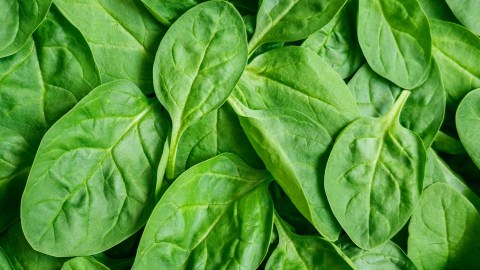Chemists propose spinach as a better, cheaper battery catalyst

Credit: Ataly/Shutterstock
- Scientists are seeking sustainable, clean chemicals for use in future fuel cell and metal-air batteries.
- Platinum is the current go-to substance for battery cathode catalysts, but it poses a number of problems, including high cost and instability.
- Chemists at American University have developed a new high-performance catalyst from simple spinach, although its preparation as a catalyst is anything but simple.
As we look to power tomorrow’s devices sustainably and economically, there’s a great deal of research going into the development of better, cleaner battery technology. Showing particular promise are fuel-cell and metal-air battery technologies. Though both continue to operate using the anode/cathode/electrolyte paradigm of current batteries, the race is on to find more sustainable materials that can replace those in current use. A new study published in the American Chemical Society’s open-source journal ACS Omega proposes that one solution may be Popeye’s favorite superfood: spinach.

Flow of energy when battery is in use, dischargingCredit: VectorMine/Shutterstock/Big Think
Electrons travel within a battery from one electrode, called the anode, through the battery’s electrolyte — either a powder or liquid barrier — to another electrode, called the cathode. The anode releases these electrons through a chemical process called oxidation, while the cathode accepts them through another, an oxygen reduction reaction. Together, this exchange is called a “redox.”
The electrons’ return trip back to the anode, however, requires a “load” provided by an external device, which is fine, since that device — a flashlight, a phone, or a car, for example — operates on the energy produced by the battery’s electrons passing through.
The electrons travel out from the cathode’s positive terminal to the device then return to the battery’s negative anode terminal. In this way the energy travels round and round the battery-device circuit. (When charging a battery, electrons go in the opposite direction connected to a charger.)
The new study is concerned with the catalyst that produces the cathode’s oxygen reduction reaction.

Credit: AlexLMX/Shutterstock
Fuel cell batteries and metal-air batteries use the surrounding air outside the battery as their cathode. It’s clean, free, plentiful, and it works, as long as there’s a catalyst that can adequately prompt the requisite oxygen reduction reaction.
The most commonly used catalysts for such batteries have been based on platinum. There are problems with these, though. Of course, platinum is expensive. Also, as the study notes, “the lack of long-term stability and the vulnerability to surface poisoning by various chemicals such as methanol and carbon monoxide, call for the development of non-Pt group metal (NPGM) catalysts.”
Researchers have therefore been exploring non-toxic, carbon-based catalyst alternatives since they may be more stable and exhibit resistance to surface poisoning. And because carbon is everywhere, they’d be inexpensive to produce. However, some of the materials being investigated don’t do the job as well as platinum-based catalysts. The chemical reaction they produce is slow, posing a speed bottleneck to the flow of electrons.

Credit: Liu, et al./ACS Omega 2020, 5, 38, 24367-24378
Shouzhong Zou, of American University’s Department of Chemistry, is the paper’s senior author. The lead author is Xiaojun Liu, with Wenyue Li as co-author. Professor Zou reports:
“The method we tested can produce highly active, carbon-based catalysts from spinach, which is a renewable biomass. In fact, we believe it outperforms commercial platinum catalysts in both activity and stability. The catalysts are potentially applicable in hydrogen fuel cells and metal-air batteries.”
While other catalyst research has involved plants such as rice and cattails, Zou believes spinach has a few things that make it a superior candidate as a catalyst material. For one thing, it’s rich in iron and nitrogen, both essential catalyst ingredients. In addition, it’s easy and inexpensive to grow, and it’s abundant.
Zou and his students developed spinach-based carbon nanosheets a thousand times thinner than a human hair. The process is complex, a combination of basic and advanced techniques.
To begin, the researchers washed, juiced, and freeze-dried the vegetable before grinding it by hand into a fine powder using a mortar and pestle. Next, the spinach powder was dissolved and mixed with melamine, sodium chloride, and potassium chloride in water and cooked together at 120°C. This mixture was then rapid-cooled in liquid nitrogen and freeze-dried. Then it was pyrolized twice.
It may well have been worth the effort. Measurements of the resulting nanosheet indicated that it can out-perform platinum as a catalyst in both speed and stability. Of course, that’s on top of being made from such an unassuming, inexpensive, and widely available plant.
“This work,” says Zou, “suggests that sustainable catalysts can be made for an oxygen reduction reaction from natural resources.” The next step for Zou and his students is to try out their spinach catalyst in prototype fuel cells to assess its performance in action. They’re also looking into the use of other plant materials for catalysts.
Finally, Zou understandably hopes to develop a simple, less energy-intensive way to make their catalyst nanosheets.





